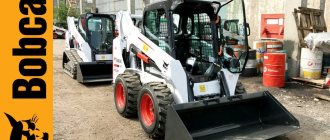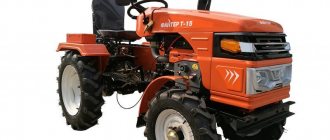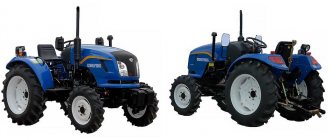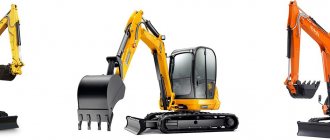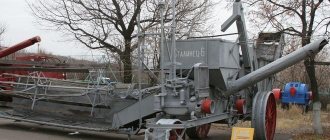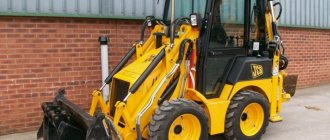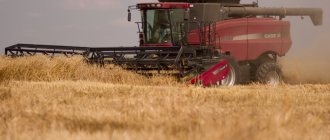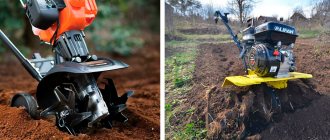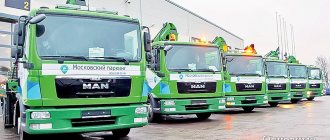We spoke to mini excavator experts about what a buyer should look for when choosing these machines. A common thread in the recommendations of all our interlocutors was the thought expressed by one of them: “Quality is everything.” This means that you need to select the best possible options and you also need to approach the selection process as conscientiously and carefully as possible. So, expert recommendations for you!
The mini-excavator market is constantly evolving: new developments and improvements in the design and functionality of machines appear. These new solutions provide mini excavators with increased productivity, increased capabilities, simplified maintenance, safety, improved operator comfort and cost-effectiveness, affordability.
In 2022, the mini and compact excavator segment is one of the most dynamically developing in the global construction equipment market. These small machines, capable of handling a variety of interchangeable attachments, are growing in popularity among construction contractors and construction equipment rental companies.
The main factors that determine their popularity are versatility and small dimensions. Compact excavators are easy to transport from one site to another; at construction sites they can perform a wide variety of work: digging trenches and pits for foundations, laying underground utilities, compacting soil with mounted vibratory rammers, drilling holes with a hole drill for planting trees, hauling huge decorative stones and fragments rocks for landscape design and much, much more.
On sale on the Russian market you can find many models of New Holland of several generations weighing from 1060 to 8340 kg, with diesel engines with power from 6 to 41 kW and digging depths from 1750 to 4520 mm. The cabin is comfortable, the operator is provided with all-round visibility, and the transmission is two-speed. All models are equipped with a bulldozer blade for the width of the machine. There is an additional double hydraulic line for installing replaceable attachments: buckets of various sizes, auger drills, hydraulic hammers, hydraulic tongs for crushing and hydraulic shears for cutting metal beams. Upon request, a device for quick connection of working tools can be installed.
Model overview
The category of such excavators includes units weighing 1.5-9.0 tons. According to the description, they are small in size, have good maneuverability, and allow you to perform work in cramped conditions. They can be electric or powered by an internal combustion engine, tracked or wheeled, trailed or self-propelled.
They are used when laying utility networks in trenches, during road and construction work, when digging pits for poles, bushes, trees, and as loaders.
They have replaceable attachments, which allows them to work as loaders, bulldozers, and lift loads. The latter expands the functionality of the mechanisms, making them economically unalternative when performing small volumes of work and their variety.
This type of special equipment is produced today by manufacturers in many countries. There are Russian products on the market. Japanese units are available for sale, characterized by traditionally high quality and reliability. Due to the optimal price-quality ratio, devices supplied from China are becoming increasingly common.
Conclusion
Summarizing all that has been said, it can be noted that, knowing for what work the equipment is purchased, and taking into account the characteristics discussed above, choosing a mini-excavator will be very difficult.
Similar articles:
- How to choose the right tulle width for a window: recommendations
- The best manufacturers of bamboo pillows: selection tips and ratings
- Which cardio machine is better to choose for home: comparison of models
- How to choose a gaming wheel: with or without pedals
- What furniture to choose for the bedroom: selection of interior and bedroom set
The following two tabs change content below.
- Bio
Editor: Denis Nazarov
Position : editor-in-chief. About me : Generalist specialist. Experience as an editor and author of articles as a journalist for more than 12 years. He graduated from the Faculty of Philology of the Belarusian State University (Department of Russian Language and Literature) and received a diploma in the specialty “Philology. Teacher of Russian language and literature."
Articles from the author: Denis Nazarov (all articles)
- How to choose a good hand expander: comparison of models - 12/01/2020
- How to choose a gaming wheel: with or without pedals - 12/01/2020
- How to choose a gaming chair for your computer: tips - 12/01/2020
Japanese
Mini-excavators from Japan are presented on the Russian market by different manufacturers. Among them is the Yanmar company, considered the founder of this type of technology. She released the first copy of the car 50 years ago, and today she has developed 4 series (with indices B, SV, VI, YB), including almost 80 models. Most Yanmars move on tracks; there are products on wheels.
Features of the units:
- the most comfortable and understandable controls;
- a minimum of electronic components and components, which simplifies and reduces the cost of repairs;
- trouble-free operation at low temperatures;
- reliable engines of our own production;
- the presence of a counterweight located within the boundaries of the track, allowing work to be carried out directly near the walls, eliminating breakdowns due to contact with external objects, increasing the level of safety for the operator;
- the presence of a hydraulic motor of increased power to rotate the platform, which speeds up the process of digging the soil and increases productivity;
- the presence of cabin protection against falling objects and overturns;
- specially configured buckets;
- complete set with additional replaceable equipment - drills, hydraulic hammers;
- increased work resource;
- small weight, dimensions;
- reduced fuel consumption.
Among the Japanese manufacturers of small excavators is Hitachi. Cars with this brand:
- strong and durable;
- with low operating costs;
- with high performance;
- with a comfortable and safe cabin with all-round visibility;
- with convenient and precise control;
- equipped with standard and special buckets that allow cleaning trenches and facilitating the development of clay soils;
- are provided with developed service support.
The most compact machine from the Hitachi family is the EX16-2B model. It weighs 1.6 tons, has a boom reach of 3.68 m, can dig soil at a depth of 2.17 m, operate as a forklift, and unload material from a height of 2.33 m. It is equipped with:
- buckets with a volume of 0.02-0.045 m³;
- Kubota engine with a volume of 1.123 liters and a power of 17.5 hp. With.
Other modifications with technical characteristics:
- with Kubota power units producing 17.3, 26 hp. With.;
- weight of mini-excavators - 3.0, 3.4 tons;
- bucket volume - 0.04-0.1 m³;
- digging depth - up to 2.9, 3.14 m;
- height of unloading materials - 3.42, 3.80 m.
The difference between the Zaxis series and Hitachi is the tracked propulsion, the absence of skidding of the rear part, which, when turning, remains within the boundaries of the tracks. The latter eliminates involuntary damage by the machine to external objects.
The models are environmentally friendly and do not cause any noise during operation. They can dig trenches 2.2-3.2 meters deep. They are equipped:
- a canopy that protects the operator from falling objects;
- buckets with a capacity of 0.02-0.11 m³;
- power units Kubota, Isuzu;
- rollover protection.
Among the popular manufacturers in Russia is the Takeuchi company with 5 machine models: TV016, 108, 125, 135 and 145. They differ:
- weight (0.84-4.84 t);
- dimensions (2.71x7.4x2.11/5.52x1.84x2.50 m);
- bucket capacity;
- engine power;
- turning radii (0.8-1.47 m);
- width of tracks (18-40 cm).
All Takeuchi mini-excavators have a crawler track, which reduces ground pressure and expands the range of use of the machines. The design provides special places for attachment to a helicopter, which can deliver them to the most remote and hard-to-reach places. The differences:
- adjustable track track width;
- the presence of a cast iron counterweight that protects the engine compartment from damage;
- optimally placed center of gravity, increasing the stability of the product when moving and working;
- the most comfortable cabin for the operator with sound insulation, air conditioning, heating system, stereo radio;
- the presence of a boom limiting device that prevents damage to the hydraulic system.
The machines are equipped with various interchangeable equipment, which increases their versatility. These are hydraulic hammers, cutters, grabs, drills and brush cutters, hydraulic shears, mulchers, and harvester heads, which are typical for municipal equipment. They are installed through ports and controlled by a hydraulic system. The latter has a volume of 7.4-74 liters and operates at a pressure of 160-245 bar.
Among the founders of mini-equipment is the IHI company from Japan. The small excavators produced by it are distinguished by maneuverability and good maneuverability. They:
- due to the design features, they are stable during movement and operation, with high productivity;
- are able to work with a large range of additional equipment, therefore they are used in different industries;
- They are equipped with engines, electrics, and hydraulics made in Japan, therefore they are unpretentious in operation and reliable.
Advantages
The popularity of JCB mini excavators is due to a number of technical parameters. For example:
- Comfortable cabins with an increased level of safety, sound insulation and vibration absorption.
- Panoramic glazing that provides all-round visibility.
- The controls are arranged in a single unit, which optimizes the workflow.
- The use of a tubular boom, which is much lighter than flat structures, but has an increased margin of safety.
- Precise hydraulic operation that enhances explosive force at the edge of the bucket.
- Dozer blade that provides increased stability during heavy-duty work.
It is worth clarifying that JCB mini-excavators are adapted to work in harsh climatic conditions. In addition, the main components and mechanisms are freely accessible for maintenance and repair.
Chinese
Excavators of this type from China, supplied to the domestic market, are produced mainly by 2 companies - Sunward and Yuchai. The latter's products are marked with the YC index and are offered for sale in 9 models. 8 of them are equipped with Japanese Kubota diesel power units of different power (14-61.6 kW), the YC55-8 product is equipped with a Yanmar engine (36.9 kW).
In addition to power units, the differences between Yuchai models:
- total weight - 1.72-8.10 tons;
- bucket capacity (0.02-0.32 m³), their width (40-87.5 cm).
An interesting towed vehicle from the Celestial Empire is NVR-9. It is similar to the German Landformer excavator and is produced under license. The mechanism has wheels at the front and support rods at the rear. To accommodate a 9 HP engine. With. Rubber cushions are used to reduce vibration. The engine has low gasoline consumption and is started manually.
The HBP-9 model weighs 465 kg, is equipped with a standard 30 cm wide bucket. It creates a digging force of 800 kg and can rotate 120°. Digs to a depth of 2.2 m.
The NVR-13 model has a more advanced design. It is equipped with hydraulic supports that more effectively keep the machine from turning over and shifting during operation. This also made it possible to increase the boom rotation angle to 160°. The unit is offered with a whole range of additional equipment - grippers, leveling and large-sized buckets, concrete crushers.
Case
The Case range of mini excavators weighing up to 3 tons includes 5 models: CX15B, CX17B ZTS, CX18B, CX26B ZTS and CX30B ZTS. The 1.5-ton Case CX15B Series 2 features two variable-displacement piston pumps that precisely match hydraulic flow to demand, reducing fuel consumption and improving performance. All older models are equipped with an additional third gear pump that powers the swing circuit and blade. When required, flow from this pump is directed to the bucket and arm to optimize digging power. A speed selector is built into the right drive control lever. The CX15B, CX17B, CX18B use a new Mitsubishi engine with a power of 11.3 kW. All older models are equipped with Yanmar engines with a power of 17 kW (for CX26B and CX30B models) and above. Available with a canopy or cab, operator safety is guaranteed by FOPS/TOPS standards and, for CX26B and above, by ROPS. The three-post canopy provides very easy access to your work area. The new cab features a suspended seat and a powerful heating system. Three zero-swing models - CX17B, CX26B and CX30B - have operating weights from 1.75 to 2.87 tons and digging depths from 2.37 to 2.79 m. The CX17B and CX18B are equipped with a hydraulically variable track width for providing the necessary wide support when digging and ensuring unobstructed passage through narrow openings. These models are equipped with a folding blade, the width of which varies depending on the track size without the use of any tools. Hinged side panels and easy ground-level access to the battery and all service points ultimately reduce maintenance time and increase productivity.
Russian
There are few manufacturers of small excavators in Russia. Today they are produced at domestic factories in Chelyabinsk (Geogid brand, EO-112M), Zelenograd (Lendformer), Belgorod region (Mini Digger-2500), Tver (J8), Volgograd (Scorpio).
Geogid units are produced by the Chelyabinsk Pride holding company. They are characterized by high productivity, which is ensured by a short operating cycle:
- Model 15G. It is trailed, with a 15 hp gasoline engine. With. Weighs 750 kg, has dimensions 238x125.5x284 cm. The machine does not have a cabin, a blade, or a rotary support mechanism. There is a rotary handle and a small (0.02 m³) bucket. It is used for constructing 2.2-meter trenches and lifting loads to a height of up to 2.5.
- Model 20G. The car is self-propelled. It is produced in 3 modifications - premium, basic, standard, which have different operating comfort and additional equipment. Weighs 2.2-2.35 tons, dimensions - 353x155x345 cm. The bucket is 30 cm wide, volume - 0.4-0.5 m³. The engine runs on gasoline and has a power of 20 hp. With. The machine is capable of digging pits 3 meters deep and lifting loads by 2.5-3.3 m. Available in other configurations:
- 20D, featuring a more powerful (27 hp) engine;
- 60DC-P, which has increased dimensions and weight (respectively, 350x126x360 cm, 2.4 tons), a diesel power unit with a capacity of 60 hp. With.
Landformer machines are the development of the German company of the same name. They are trailed. They weigh 520-530 kg. Produced by Kromo-Stroy from Zelenograd with different engines:
- gasoline Lifan and Honda with a capacity of 15 hp. With.;
- less powerful (10 hp) Lifan, running on diesel fuel.
Features of Landformer trailed mini excavators:
- high (90%) supply of domestically produced parts and components;
- good maneuverability, ease of use;
- possibility of attachment to a pontoon, which is used when cleaning river beds;
- ability to dig pits 2.3 meters deep.
The basic Landformers come with 2 buckets of different widths and volumes, 35 and 22 cm, 34 and 22 liters, respectively. On request they are additionally equipped with:
- bulk bucket with a capacity of 57 l, width 55 cm;
- a rake that can be used to loosen the soil, sort garbage, and remove small stumps.
The Mini Digger-2500 machine is an improved version of its analogue of the same name from China. Adapted as much as possible to domestic conditions. It is a 2-wheeled model, has 2 outrigger supports, and a 15 hp engine. pp., running on gasoline. Manufactured by Stanki 31 LLC from the Belgorod region.
The weight of the Mini Digger wheeled mini-excavator is 550 kg. It is small and can be easily transported by a small truck, passenger vehicle, ATV, or tractor. It is equipped with 3 buckets with a width of 60, 35 and 25 cm, additionally equipped with a stone and log grabber and a crushing hook. Capable of digging trenches 2.5 meters deep, providing a productivity of 8 m³ per hour.
The EO-112M excavator is the brainchild of a tractor plant from Chelyabinsk. It is self-propelled, tracked, and is the largest one produced in Russia. Is different:
- equipped with turbocharged engines from Germany and Italy running on diesel fuel;
- high (50 hp) power;
- shifting the digging plane by 0.95 m, allowing for cultivation of the ground next to the foundation;
- large plane of cabin glazing, its ventilation;
- the presence of self-diagnosis;
- a wide variety of bucket volumes - 0.18-0.8 m³.
EO-112M is suitable for working in cramped conditions. They use it to dig pits, pits, trenches 3.6 m deep, and load bulk materials to a height of up to 4.75.
The small J8 excavator was developed by Armsil. She also organized its Russian production in Tver according to her drawings. It is distinguished by the absence of analogues. Maybe:
- dig rocky, frozen soil 2 m deep with a standard bucket;
- work at temperatures -40…+40°С;
- lift weights up to 1.9 m using a hydraulic winch located on the boom;
- uproot stumps, grab logs, work with hydraulic hammers.
The unit is equipped with an Italian hydraulic pump, Lifan or Honda power units with a capacity of 9 liters. With. All other parts and components are made in Russia. The machine can screw in piles and work with a drill, which is attached to the end of the boom.
Excavators Scorpions, produced in Volgograd, are trailed, small in size. They weigh 650 kg and are transported to the place of work by a passenger car. They are equipped with a seat for the operator, buckets 16-45 cm wide, and a fuel tank with a capacity of 22.5 liters. Despite its small dimensions, it is capable of loading materials to a height of 2.2 m.
Bobcat
The latest generation models of this brand’s excavators – E17, E19 and E20 – have recently been released. The new range, which took almost three years to create, is produced in the Czech plant and is equipped with quiet three-cylinder Kubota engines. The developers put operator comfort and maximum compactness at the forefront. The cars received spacious cabins with improved visibility and gained a little weight. Bobcat E20 is designed with zero platform offset. This compact machine can easily handle tough jobs in the tightest spaces, near fences and buildings. A special switch on the operator console sets the mode in which attachments, such as an auger or hammer, can operate independently without the operator having to constantly keep his finger on the button. The track widening/narrowing function is also activated by a switch on the left side of the control panel. The switch for controlling the blade is also located here.
How to choose a mini excavator
To begin with, they determine the purposes for which such a unit is needed. If you plan to use it rarely, for a summer residence, or for small amounts of work, then a small model is suitable. To implement large projects and run a business, you need more powerful equipment, with greater reliability and productivity.
Then they compare prices and choose the one that suits them. For short-term use, you can try to make a small unit yourself or rent a car, but you need to take into account the costs of insurance, fuel, and transportation, which amount to 7-10 thousand rubles/day.
They study in more detail the capabilities of the selected option, reviews of the loader, the location of controls, and the need to register the machine. They are familiarized with stickers, safety precautions, model features, maintenance data, country and date of manufacture.
They try to control the mechanism, move on it, and perform earth-moving work. If they feel comfortable, they decide to buy.
Caterpillar
The line includes seven models of mini-excavators with an operating weight from 0.63 to 2.67 tons (300.9D, 301.4C, 301.7D, 301.7DCR, 302.2D, 302.4D, 302.7DCR), which are produced by the Austrian company Wacker Neuson under the brand Caterpillar. These small excavators share many of the same features of their big brothers, including a spacious cab and sophisticated hydraulic systems. An extended handle is available as an option on most models. One of the most popular models in the line is the 301.7D with a weight of about 2 tons. The hydraulic hammer line and auxiliary line with bi-directional flow provide the ability to control various equipment, such as an auger drill. Auxiliary hydraulic function is controlled by a proportional control on the left joystick, which allows the operator to vary the auxiliary hydraulic oil flow rate to suit the needs of a specific work tool. Quick-release connections are equipped with a hydraulic accumulator, which speeds up equipment changes. As standard, the machine is equipped with a sliding chassis and a folding dozer blade with a retracted width of 990 mm. When extended to the full working width of 1300 mm, the undercarriage is more stable, resulting in increased digging force and loading performance.
Mini excavator control
They do this by sitting in the cab on the operator’s seat and fastening their seat belt. The bucket and cab rotation are controlled by joysticks on the armrests, and the loader turns are controlled by two levers located under the feet. When one of them moves forward, it should turn in the opposite direction, towards itself - in the same direction.
On the floor on the left in the cabin there is a button or pedal, after pressing with your foot the excavator begins to move quickly. On the right is a pedal (covered with a steel plate) that turns the bucket left and right. If the operator’s skills are insufficient, it is better not to touch it - the chance of the unit overturning increases.
On the right, closer to the operator, there are 2 more levers. The near one regulates the engine speed, the far (larger) one turns on the bulldozer blade. When pulling towards oneself, the latter rises, and when pulled away from oneself, it lowers.
After-sales support and warranty
From the topic of maintenance it is logical to move on to the topic of after-sales support. The mini excavator you choose should have everything optimal: a reliable, easy-to-use design, high-performance work, and after-sales support. If you can't afford to have your machines often idle and in need of expensive repairs, don't forget to find out how the selling company organizes after-sales support - this is also the most important factor in your choice. Find out the delivery times for spare parts and service. You also need to make sure that your financial investment will be protected for a long time: study the conditions under which the seller provides the guarantee: what is its duration, what does the guarantee cover, is it possible to extend the warranty period and what is the cost of this option.
Kubota
In 2014, Kubota launched the U27-4 compact mini-excavator with zero reach, which, according to the manufacturer, is equipped with the largest and most comfortable cab in its class. Three more U-series models and five traditional KX-series models ranging from 1 to 2.79 tons complete the Kubota line-up. All excavators are equipped with engines of the same name with power ranging from 7.4 to 20.5 kW. Of particular note is the 2.5-ton U27-4 with a digging depth of 2.82 m. When simultaneous operation of the boom, arm, bucket and slewing device is required, two variable displacement pumps distribute the exact volume of working fluid for each drive in proportion to the movement of the lever management.
Yanmar
The new Yanmar SV16, SV18, SV22 and SV26 models are equipped with fuel-efficient Yanmar engines (auto idle is available as an option). The new line's hydraulic 3-pump system VIPPS (ViO Progressive 3-Pumps System) allows three movements at the same time, which, according to the company, provides excellent productivity, faster cycle times and smooth control of the work group. In total, Yanmar produces 10 models in the class up to 3 tons.
Statistics show that sales volumes of mini-excavators fall slightly even during a recession. The main competitor of this machine today is a man with a shovel, or more precisely, a team of diggers. A simple calculation shows that the cost of work using a mini-machine is lower, and the digging speed is higher. In addition, dense rocky soil can be an insurmountable obstacle for a shovel, but not for a mini excavator. The results of this machine often cause sincere surprise among those who encounter it for the first time. The advantages include low operating and maintenance costs (private owners “with their own hands” repair this equipment themselves) and a large assortment of attachments. Analyzing the sales volumes of mini-excavators in the Chinese and Indian markets, one cannot help but note a clear trend towards an increase in the share of this class of machines in the total sales of construction equipment. Considering the relatively low cost of manual labor in these countries, it can be argued that the Russian market for mini-excavators is still very far from saturation.
Technical specifications in numbers
- Overall dimensions – 3.57 m x 1.8 m x 2.23 m.
- Wheelbase – 1.07 m.
- Operating weight – 3238 kg.
- Loader bucket capacity – 0.31 cubic meters. m.
- The width of the loader bucket is 1,430 m.
- Reach at maximum unloading height – 300 mm.
- Maximum digging depth is 3.08 m.
- Digging depth when folded is 2.551 m.
- Reach from the articulated joint when folded is 3.38 m.
- Reach when loaded at height when folded - 1.792 m.
- The reach of the boom equipment is 3.91 m.
- Ground clearance on stabilizers - 0.27 m.
- Ground clearance along the rotary carriage of the excavator is 0.33 m.
- Engine power – 49 horsepower (37.3 kW).
- Operating voltage – 12V.
- The generator current is 50 Amperes.
Komatsu
The line weighing up to a ton includes two “micro models” PC01-1 and PC09-1 (engine power - 2.6 and 6.2 kW, respectively, and digging depth - 1 and 1.5 m). The line weighing from 1 to 3 tons includes five models (engine power - from 11.6 to 15.7 kW, with digging depths from 2.25 and 2.72 m). Features of these models are the minimum turning radius and the presence of a hydraulic line for additional attachments. It is also worth noting the new instrument panel, proportional control joysticks, low noise levels and good visibility from the workplace.
Wacker Neuson
Eight mini excavators, two of which are zero reach, fit into the 1 to 2.75 tonne category. ET Series models are available with a long or regular boom. The 803 microexcavator allows you to use an electric motor as a drive instead of a built-in diesel engine using an electro-hydraulic device from the same manufacturer that is connected in auto-configuration mode. For ease of transportation, the device is suspended directly from the excavator blade. The turntable tilt feature allows for precise vertical digging on inclined surfaces.
Terex
Seven models make up the company's lineup, ranging from the TC10 (1.16 tons) to the TC29 (2.9 tons). The company uses Yanmar engines for small models and Mitsubishi engines for large models, with power ranging from 7.6 kW to 17.5 kW at digging depths from 2.19 m to 2.8 m. The Twin Drive TC16 version is equipped with both diesel and electric motors, which located under one hood. In operation, this version is no different from the regular TC16. The diesel engine is used when the excavator needs to move. The electric motor allows the machine to be used indoors; in this case, the excavator operates almost silently and without vibration.
Operator working conditions
The cabin of the HR12 mini-excavator has good sound insulation, a felast floor covering, is equipped with impact-resistant glass, a lifting front (wind) glass, an adjustable seat, halogen headlights, and a radio. The cabin and front window are heated. Both cabin doors open to an angle of 180 degrees and are fixed in extreme positions, which makes getting in and out of the driver more convenient. To ensure good side visibility both with open and closed doors, they are equipped with upper and lower glass, which occupy at least 80% of the doorway area. The strength of the doors is achieved thanks to the centrally located belt in the steel part of the door body. It houses a handle with a lock for locking the cabin. The front of the cab is completely covered with glass, which provides a better view of the boom and working element.
